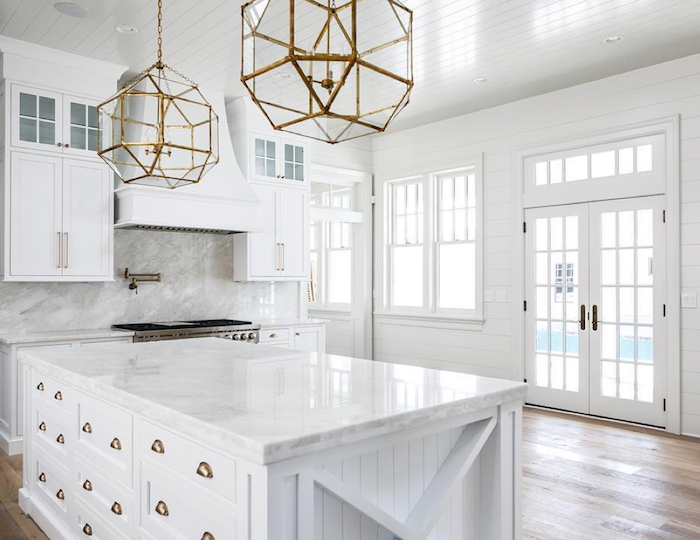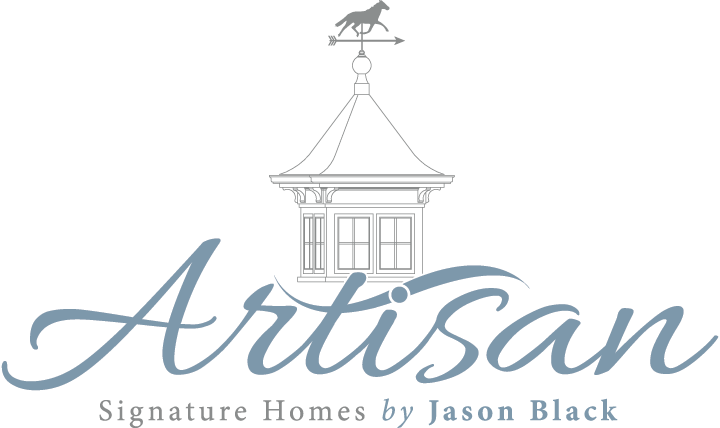
18 Jul Kitchen Counter Options For Your Next Custom Built Home
Greg: Welcome to this edition of the Louisville Custom Home Builder podcast series, brought to you by Louisville’s leading luxury construction team, Artisan Signature Homes. I’m Greg, your host and for today’s episode, we are joined by Louisville’s best-known and most-accomplished custom and luxury home builder, Jason Black. Jason, always nice to see you.
Jason: Greg, it’s good to have you back.
Greg: Thank you, sir. I’m excited to talk about kitchens today. I love hanging out in kitchens, so I’m hoping you can help me figure out countertops and if there is a best surface or if it depends on what I want to do with it, but can we talk about kitchen countertops?
Jason: Well, it’s a pretty hard topic.
Greg: Ba-doom-doom.
Jason: If you’d like to, let’s talk different surfaces. It’s really a nice way to finish off a beautiful kitchen and there are a lot of options out there these days for homeowners.
Greg: I would imagine so. I know when I’m talking to people, it seems people are divided in a couple camps. Some people pick the countertop first and then go cabinets. Other people are like, “I’m going to pick my cabinets and go countertops.” I think I’m in the countertop-first department. I know that a lot of people design their whole kitchen, I’m sure, around the countertop and go from there.
Jason: That’s right, that’s right. I do it both ways. We build a fair amount of spec homes and custom homes and sometimes will get the countertop first, sometimes we’ll get the cabinets first. Right now with the trend being white cabinets, the cabinets are coming first and the lighter-color granites and marbles and quartz products are becoming more and more popular right now.
Greg: Is there one that’s better than another, the material, or does it really depend on what people do in the kitchen: how often they cook, are they putting hot pans on there?
Jason: Yeah, I think it depends. There’s some big differences, so I guess a couple of the main countertop surfaces are you have granite, which is a natural stone. You have marble, which is natural. Then you have a product called quartz, which is a man-made product. Maybe we’ll talk a little bit about quartz first and some of its advantages.
It’s one of the strongest materials on the planet. It’s stronger, more flexible than granite, which makes it easier to work with during fabrication and installation. We’ve had times where we’ve had some delicate granite or marble that’s cracked or crumbled during install progress. You know, time you cut the sinks out and whatnot, you get some weak points. That’s an advantage to the quartz.
Greg: Can I ask you a question about quartz?
Jason: Yeah.
Greg: I’m raising my hand. I’m a little confused. I thought quartz was a natural product. Are you saying that there is a natural quartz, but when people talk about quartz countertops, that’s sort of a man-made combo or a man-made substance that might have some natural quartz in it?
Jason: That’s exactly right.
Greg: Okay. There aren’t big slabs of quartz, the mineral, laying around that you mine the same way you would limestone, and so it has to be fabricated.
Jason: That’s right. I think almost 90% of quartz is natural and then maybe 10% is resin. Sometimes that’s why people still refer to quartz as natural stone. It’s not as natural as granite.
Greg: Okay.
Jason: Most fabricators create quartz countertops and do it the same way as they do with granite. They still cut it and form it the same way. Anyway, we were talking about the strength of quartz. It makes it very durable. It’s not indestructible, but there really is no product as durable as the quartz. One of the things, some people who are maybe germaphobes or don’t like to seal their granite, quartz is a good option for them because it’s a non-porous and, again, it doesn’t require any sealing. It’s a huge benefit because you don’t have to worry about bacteria and other germs growing in any nooks and crannies.
Bottom line is quartz is incredibly easy to clean and maintain. They’re stain-resistant. Dropping a glass of wine or leaving water on there just simply requires a damp cloth to clean it. Those are some pretty nice advantages. If you’re thinking about marble or stone, a lot of people freak out immediately. They’re like, “What if I spill wine or my kids are messy? I don’t want to have to have a wine glass spot on the countertop for years to come.”
Greg: That’s the knock on marble, right?
Jason: It is, it is. I personally have always been a marble fan. My last personal home, I got scared off by everybody saying don’t do the marble and so I ended up not doing the marble. Then of course as a builder, we’ve moved fairly often. Just moving into my new home and ended going with marble because to me, it just really gives you that nice, classic look, and I’ll deal with the maintenance. It’ll get better with age, in my opinion.
Greg: There you go, you’ll be able to remember a party that you had by that stain and that other stain is another story of yours from something else.
Jason: That’s right. That’s right.
Greg: What about heat resistance?
Jason: You know, all these products are heat-resistant. You can pull out your pot and set it on the counter and not have to worry about it staining.
Greg: I’ve heard about marble that you can’t put a pan from the oven on marble. Is that just not the case? Depends how hot it is?
Jason: I think it depends how hot it is and what’s underneath of it. I always try to put something under it, but occasionally I don’t and set it on there and haven’t had any issues just yet. One of the other big benefits of quartz for people, before we get into the granite, is the consistency of the quartz is very uniform. If you look at a sample in the showroom of quartz, you can pretty much guarantee that’s what’s going to be your countertop. With granite, that’s not the case. You get a very uniform finish with the quartz. If you like it, you know that’s what your countertop’s going to look like.
One of the cons I’ve heard about quartz, and I’ve not experienced this personally, but heard that it can discolor over time when exposed to direct sunlight. We don’t recommend using this surface on any outdoor kitchens or patios or something like that. The other con is you can expect to see a seam with the quartz countertop, but you’re going to see a seam with almost any kind of countertop. That kind of is the lowdown on quartz. If you’re ready for that kitchen renovation, quartz could be a good option for you.
Greg: One more question for you on quartz.
Jason: Yep.
Greg: I have to interrupt, right? That’s what I do.
Jason: That’s what you’re here for.
Greg: That’s right. Does it come in the same size sheet? I don’t know what granite comes in or marble comes in. It seems like 8′ maybe by 4′. Something along those lines. Is it the same?
Jason: Yeah, they’re all going to vary just a little bit, but quartz can be made a little bit bigger. The problem you run into, you can only make it so big because the fabricators got to handle it and move it. All the slabs are pretty similar in size. Some may be a little bit smaller. Some may be a little bit larger. They’re all generally about the same size.
Greg: All right.
Jason: Let’s talk a little bit about the granite. I guess one of the biggest pros is it’s made by Mother Nature and it’s 100% natural. I think that’s why it’s such a popular choice with homeowners, designers, and even architects these days. It may not be quite as strong as quartz, but it doesn’t mean it’s a wimpy choice, either. It’s still a strong and extremely durable stone, but just like quartz, it’s not indestructible. It can break or chip if abused. If you happen to spill red wine on it, it may stain. That’s why we recommend you want to seal your granite maybe once a year or something like that.
Another great thing about granite is every slab is a one-of-a-kind. It’s a creation. It’s unique. It’s kind of like a thumbprint. Each granite slab is exactly that. It’s excavated from the earth and cut into smaller pieces, so you’re never going to have two slabs that are the same, which is pretty cool.
Greg: It’s very cool. That goes for even inside one kitchen. If you have a big island and then a long run on a countertop, from one end to another it might be a little bit different. There might be a dark vein through one side that’s not there on the other. Yeah, I think it depends on what you’re looking for. You said the person who appreciates uniformity might lean towards quartz.
Jason: Yeah. One thing I recommend to folks is when you go to the granite yard and pick out, I always like to go to the granite yard and I like to see the actual slabs. I usually don’t ever pick from samples. Sometimes the guys roll their eyes when I walk in because I make them move every slab and I want to see the front. I want to see it. I want to see where the veining’s going. I’ll usually hand-pick all my slabs because I’ve had it time and time again, you see one slab of a lot of 10, you can’t assume they’re all going to be the same. They’ll be similar, but the veining varies dramatically from slab to slab, even cut out of the same mountain, so to speak.
Greg: For you, the sample, the little 4″x4″ square, that’s just not enough material to get an idea of what the whole thing’s going to look like?
Jason: Yeah, not at all. Even when you get into doing some smaller areas like a powder room or a master vanity, you’re going to cut out a decent portion for the sink. You want to make sure the part of the stone you like is going to be visible. They’ve got some programs so they can laser sketch on so you can actually pick the areas of the countertop and which areas you want it in your house. Pretty cool stuff out there.
Greg: Very cool.
Jason: I guess one of the cons of granite is it doesn’t offer the color consistency that quartz does. I think that’s, again, what most people like about it. The other con of granite, you are going to see the seams, but like we said, we’re going to see the seams anywhere. That kind of talks a little bit about granite and quartz.
One thing we touched on a little bit is marble. It is a little more durable, but again, it’s becoming more and more popular. I was at the granite yard yesterday looking at some slabs for our upcoming Homearama houses and they were talking about all the white marbles and there’s even some white granites coming in. With these light kitchens, there’s more and more variety and it usually does get a little bit more expensive when you get lighter because the marbles are generally more expensive.
You can get a regular Carrara marble, which is an entry-level marble price. It’s a pretty nice, crisp white. A lot of gray. A lot of gray veins. That’s where I first got introduced to marble was using a lot of Carrara. We’ve upgraded some lately with some Imperial Danby. There’s again, gosh, there’s probably thousands of different options out there, but marble is a great choice.
Again, needs some sealer. It is porous, so it takes a little bit more maintenance, but it’s been used in kitchens and bakeries all across the world for probably centuries. Figure if it’s good enough for them, it’s good enough for one of our homes.
Greg: Very nice. It’s a little softer, isn’t it? Are these the countertops that if you go into really old homes, they have little dents? Not dents, but where people just worked off the surface-
Jason: Character.
Greg: Character. There we go. Some personality in the countertops.
Jason: That’s exactly right, Greg.
Greg: A little love has been shown to the counter.
Jason: Yeah, and one thing that we didn’t even touch on is the different … Polished typically was the finish of most granite and quartz and marble. Nowadays, people are doing honed finishes, which takes the shininess off the surface. Then a real popular surface treatment that’s come along here in the last few years is called a leathered finish. They almost peel the surface off just a little bit and it feels like leather. I mean, I don’t know what else to say. If you haven’t seen it, you ought to check it out when you visit the granite yard. It’s a really cool surface and really becoming a very popular choice for a lot of our homeowners.
Greg: Are both those surfaces, the honed and the leathered, a little bit more natural in the sense that you’re not sealing it the same way, so if you spill your red wine, you’re not just worried about it in the same way?
Jason: No, you would still need to seal it and you’d still have to worry about it because, again, it exposes the actual granite a little bit. You do still have to seal it, but it’s not a completely flat surface, so it has a little undulation, a few bumps here and there. Again, it just gives it that character. We’ve got a great slab that’s going to go behind our range hood in one of our Homearama houses that’s a cool, leathered finish, so it has some really neat veining in it. If you don’t get a chance to make it to the granite yard, you can come check out, I think it’s in our Hampton Pointe house, our Home #13 in Homearama this year.
Greg: Well, you know I’ll be there, all week long.
Jason: I look forward to giving you a personalized tour.
Greg: All right. As always, thanks for the education and I’m looking forward to seeing this at Homearama.
Jason: Sounds good, Greg.



